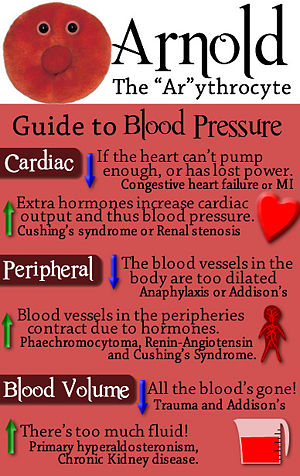Secondary hypertension
Jump to navigation
Jump to search
Definition
High blood pressure with an identifiable cause
Epidemiology
About 5% of every case of hypertension. It is more likely to have a cause in young patients.
Pathophysiology
The main causes of secondary hypertension are:
- Cardiac
- Peripheral
- Blood volume
The picture on the right might clear this up a little.
Differential
Renal
- Renal artery stenosis makes the kidneys poorly perfused. They interpret this as low pressure, and so try to increase cardiac output with the renin-angiotensin system.
- Renal failure causes fluid build up.
Endocrine
- Primary hyperaldosteronism
Other causes are:
- Pregnancy
- Drugs
- Coarctation of the aorta, lead poisoning and porphyria during acute attacks.
Clinical features
These are features where you need to suspect an underlying cause:
- Age of onset - >50 or <20 years old
- Severely high - >180/110 or evidence of end-organ damage
- Radio-femoral delay - a sign of coarctation of the aorta
- In renal disease
- Renal artery bruit - renal disease
- Mass in flank - potential renal mass caused by renal disease
- FHx of polycystic kidneys
- Endocrine
- Cushing's - causes excess cortisol, which increases vasocontriction, increasing blood pressure.
- Conn's - causes excess aldosterone, which causes hypervolaemia.
- Phaeochromacytoma - can present as sudden episodes of palpitations, with accompanying hypertension.
Investigations
Not all hypertensive patients are investigated as 95% have essential hypertension where no cause can be found. However, if there is any suspicion, the appropriate test should be done. This is list of investigations to rule out common causes of secondary hypertension.
Bloods
- Serum potassium - hypokalaemia is a sign of Conn's, Cushing's, renovascular disease and diuretics
- Serum calcium - hypercalcaemia
- TFTs - hyperthyroidism can cause high blood pressure
Urine
- 24 Urinary VMA - used in diagnosing phaeochromacytoma
- MSU - cells, casts and proteins
- urinary free cortisol - adrenal dysfunction
- renal USS, IVU, renal arteriography
Imaging
- CXR - for end-organ damage
Management
This depends on the cause. Treat the cause. Clever, eh?
